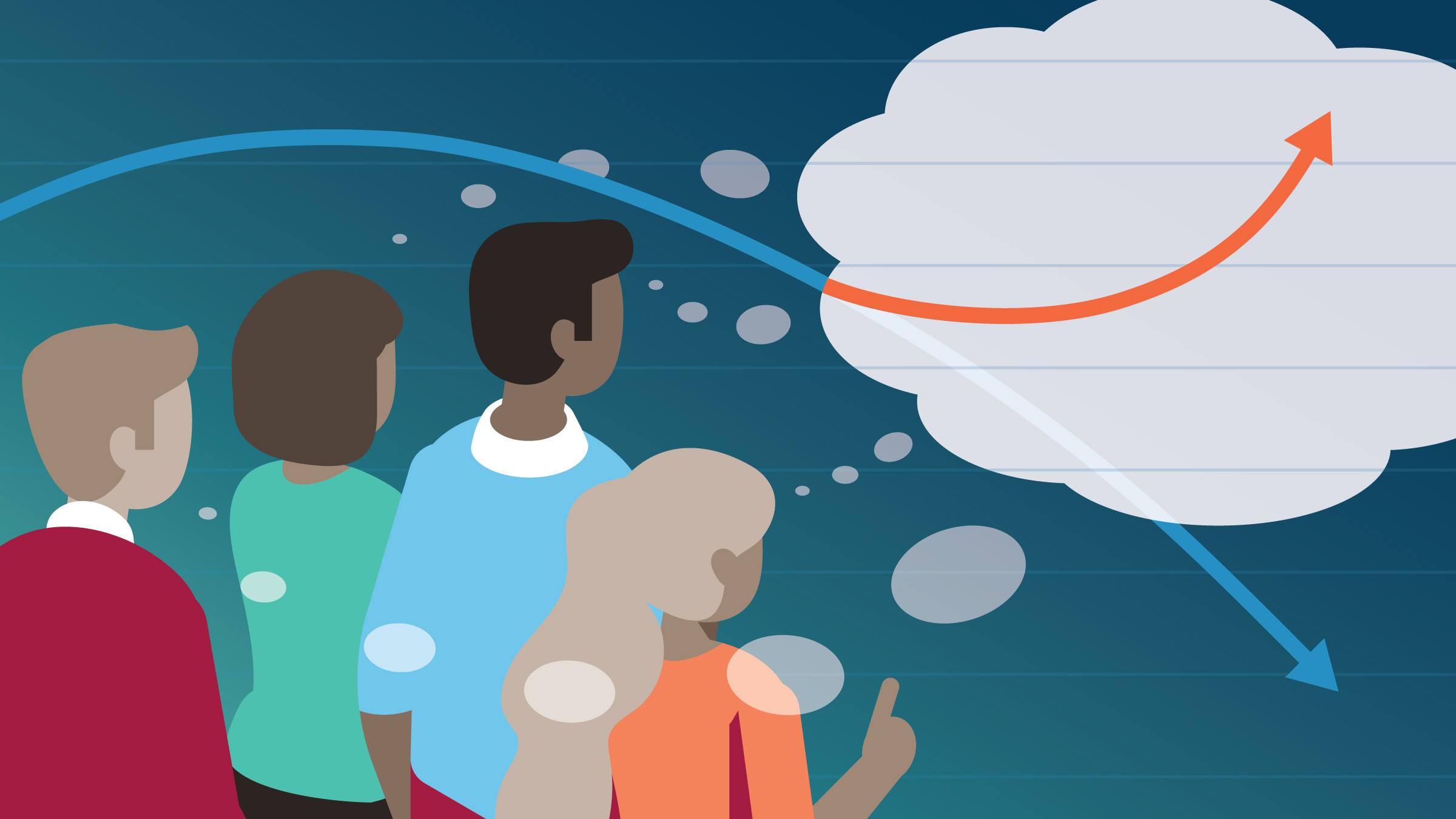According to the latest Federal Reserve Beige Book, businesses are feeling increasing cost pressure and anticipate passing those costs on to consumers. Those households, it seems, are also worried about a return to higher prices in the near term. All three major consumer surveys put inflation over the next year at more than 3 percent; two are considerably higher. University of Michigan researchers found inflation worries in recent months are “widespread and seen across income and age groups.”
Meanwhile, the outlook from bond investors, economic models, professional forecasters, and policymakers looks less alarming (Figure 1).
Importantly, any given person’s notion of “inflation” in a survey might not match the technical inflation indexes or the formulations that matter to bond market investors. (More on that below.) But the “expectations gap” evident in Figure 1 is capturing attention, based on the number of questions about it at the Fed’s latest post-policy-meeting press conference.
Consumer opinions can be easy to discount in the face of contrasting hard data. “People don’t have any skin in the game,” when answering surveys, said Fed Governor Christopher Waller this month in a forum with The Wall Street Journal. “Nothing’s going to happen to you if you’re wrong. I personally have always looked at market pricing.” Consumers also have a history of aiming too high in inflation surveys.
But consumers and businesses drive the real economy based on these expectations. Purchases and wage decisions today can shape inflation tomorrow. Think prices are going up? You’ll buy more today and push harder for a raise. In the worst case, expectations could become “unanchored” from the Fed’s long-term 2 percent annual target. If some critical mass of people come to expect higher inflation, those expectations become self-fulfilling.
Fed officials are watching closely to see if near-term worries bleed into long-term inflation expectations. “If you look a little further out, you really don’t see much in the way of an increase,” said Fed Chair Jerome Powell at the recent press conference. While University of Michigan five-year expectations jumped to 3.9 percent in March, policymakers have not seen that in other surveys or in bond markets. “We will be watching all of it very, very carefully,” Powell said. “We do not take anything for granted. It’s at the very heart of our framework, anchored inflation expectations.”
Keeping expectations anchored is of “paramount importance,” as Minneapolis Fed President Neel Kashkari recently told CNBC. So, it behooves us to think beyond the top-line survey numbers: Why are consumers much more worried about inflation right now than the pros?
Consumers are reeling from a rare surprise
Let’s look at the historical relationship between (1) the longest-running consumer inflation survey, (2) a quantitative, market-based expectations model from the Cleveland Fed, and (3) the actual inflation that materialized.1 Note that in Figure 2, the consumer price index (CPI) annual inflation readings are moved forward by a year, so that each month shows year-ahead inflation expectations and the inflation realized over the subsequent 12 months.
Some trends stand out. One is that since the 1990s, consumers usually expected more inflation than we got. In recent years, they have also routinely expected more inflation than the markets, which—until 2020—had been pretty good at predicting inflation. To that extent, the current situation looks like consumers returning to form.
Figure 2 also shows why this time might feel different. For the first time since 1980, consumers are reeling from a significant, sustained shock. In 2021 and 2022, subsequent inflation ran much higher than consumers or markets had predicted. Consumers were, for a change, closer to the unfortunate truth.
The narrowing difference between consumers and markets in the late 2010s suggests consumers were finally tempering their high expectations. If so, that progress was undermined by the post-pandemic surge. With elevated inflation not fully vanquished, we can see why faith might be shaky. The last time consumers were similarly shocked was in 1980. Those heightened expectations proved difficult and painful to quell.
Different lenses on eggs and tariffs
Already on edge from the fresh inflation surprise, news headlines may more easily inflame consumers’ sense that more inflation is on the way.
Consider the price of eggs, which recently spiked for narrow supply reasons (especially bird flu) that have little to do with underlying inflation. While egg prices are up 59 percent from a year ago, they represent less than 0.2 percent of typical household expenditures (the typical household spends almost seven times as much on fruits and vegetables). Like all food, eggs are not included in the core measures of inflation policymakers watch most closely. So, even as web searches for “egg prices” reach an all-time high, actual egg prices barely move official inflation data.
Consumers’ inflation expectations are disproportionately influenced by prices they see more often, including food, according to findings from economists at the Cleveland Fed. They note that prices for food were especially volatile after the pandemic.
Daily headlines about trade also prime consumers to expect inflation. While imports comprise an estimated 11 percent of consumer spending, tariffs lately dominate the economic news. In March, The Conference Board reported “a sharp increase in the mentions of trade and tariffs.” University of Michigan researchers noted that “consumers generally expect tariffs to generate substantial upward pressure for inflation in the future.”
Contrast this with market strategists and policymakers, who are taking a wait-and-see approach to the impact of tariffs. The investment manager Invesco cautions that tariffs themselves are highly uncertain. Recent guidance from Edward Jones notes that tariffs in 2018 had little lasting impact on prices: “While the tariffs implemented this time around are much broader in scope, we expect the impact will be a one-time increase in prices as opposed to an ongoing source of inflation.”
“We are focused on separating the signal from the noise as the outlook evolves,” Fed Chair Jerome Powell said of tariffs in a speech this month. “We do not need to be in a hurry, and are well positioned to wait for greater clarity.”
“Rates” versus “levels”—consumers don’t much care (but economists do)
Notwithstanding the price of eggs, grocery prices are up less than 2 percent from one year ago. Inflation in groceries has been slowing since the summer of 2022. Yet consumers in 2025 still name grocery prices as their top economic concern.
This makes more sense when we consider that grocery prices are up more than 27 percent from five years ago. It’s the price level that feels like a burden. But inflation—the rate at which prices are changing—is fairly tame. This rates-levels distinction is fundamental to economists and sophisticated investors. One lesson from the post-pandemic period is that the distinction means less to consumers, who do not impose any arbitrary time period when thinking about rising prices.
Consider this: As inflation peaked in summer 2020, the U.S. Census Bureau Household Pulse Survey rolled out a new question asking respondents to rate “the level of stress caused by the increase in prices in the last two months.” Not surprisingly, stress levels were high. Two years later, the survey asked the question for the final time (Figure 3).
Stress caused by inflation
Source: U.S. Census Bureau Household Pulse Survey (Sept. 14–26, 2022, and Aug. 20–Sept. 16, 2024).
By 2024, inflation had slowed dramatically. Yet people were just as stressed-out about rising prices.
“Nostalgia-flation” for prices from the not-too-distant past seems to be especially sticky when it comes to groceries. Like most things, food prices tend over time to move gently in one direction: up. Despite this long record and very run-of-the-mill price increases lately, the big change in price level between 2021 and 2023 still has consumers mired in an inflationary state of mind. Household budgets are also tighter after the change in price levels, heightening the pain of even small price increases.
Do consumers mentally separate prices and earnings?
Unlike bond investors or professional forecasters who can compartmentalize price inflation as a distinct economic indicator, consumers aren’t obligated to think about price increases in isolation from the money coming in the door.
Here, again, we have come through a shock not seen since the 1970s, and something therefore new to many working Americans. Real (adjusted for inflation) wage growth took a major hit after the pandemic (Figure 4).
During much of 2021 and 2022, real median U.S. wages declined. The only other instance in recent history was the slow recovery from the Great Recession. In that case, however, the primary culprits were stagnant wages and lingering unemployment—not a sharp rise in inflation. This time, nominal wage growth rose after the pandemic, but the even-faster-rising cost of living drove real wage growth below zero.
By one recent measure, real wages are more than 4 percent below where they would be under pre-pandemic trends. Many consumers answering inflation surveys have just come through their first-ever experience of falling behind; at the moment, real wage growth is again below 2 percent. Asked to forecast inflation, households might think broadly about affordability—not just an isolated notion of prices.
A missing, major expense: The cost of credit
The cost of debt adds to the cost of living. It does not add to inflation—not officially. For technical and conceptual reasons, interest payments on mortgages, car loans, and credit cards are no longer included (in some cases, have never been included) in official measures of inflation. Nor are they therefore factoring into professional projections of what those official inflation rates will be.
But current interest rates remain near levels unseen since the 1990s, bringing a sharp rise in household interest expenses. A new working paper from economists including Marijn Bolhuis and Larry Summers derives an alternate price index that incorporates mortgage and personal interest payments. Their index matches the official consumer price index (CPI) closely, going back decades—until late 2023, when a wide gap opens up. As of their latest data point in November 2024, CPI inflation stood at 2.7 percent. Their cost-of-living measure, which included interest payments, was around 9 percent.
The economists conclude that the cost of credit substantially accounts for why recent consumer sentiment has been poor amid a statistically healthy economy. “Consumers, unlike modern economists, consider the cost of money part of their cost of living,” they write. Their finding suggests one more reason consumers might perceive considerably higher inflation today and—right or wrong—into the immediate future.
Endnotes
1 The Cleveland Fed’s estimates of inflation expectations integrate Treasury yields, current and historical consumer price index (CPI) data, inflation swap data, and forecasts by professional forecasters. Figure 2 uses CPI data as the most appropriate comparison to the Cleveland Fed model. A version of Figure 2 using the personal consumption expenditures (PCE) price index shows similar trends.
Jeff Horwich is the senior economics writer for the Minneapolis Fed. He has been an economic journalist with public radio, commissioned examiner for the Consumer Financial Protection Bureau, and director of policy and communications for the Minneapolis Public Housing Authority. He received his master’s degree in applied economics from the University of Minnesota.






